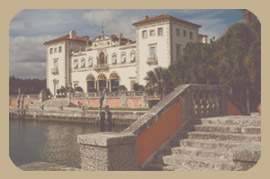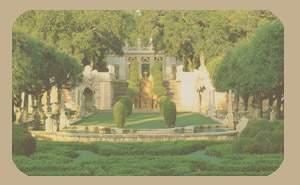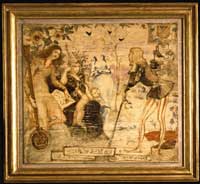Vizcaya
Vizcaya was the winter
home of International
Harvester vice president James Deering. It was located just south of
the
then-infant city of Miami facing Biscayne Bay (now in the heart of the
city). Completed in 1916, it was built as an Italian Renaissance
country
villa, self-sufficient on 180 acres with a dairy, poultry house, mule
stable,
greenhouse, and staff residences. The house took two years to build and
is based on a composite of a many Italian villa styles. The home was
fully
furnished from numerous trips to Europe by Deering and was intended to
look as if it had been occupied by many generations of his family. Room
decorations represented Renaissance, Baroque, Rococo and Neoclassic
finish.
The formal gardens were certainly begun when Sargent visited in 1916
but
were not completed until 1921 due to the outbreak of World War I.

Three architects
were
involved: F.
Burrall Hoffman designed the buildings; Diego Suarez planned the
gardens; and Paul Chalfin was the general artistic supervisor for every
phase of the project and under him worked Phineas Paist who
handled the day to day oversight. Hoffman, Chalfin and Phineas
all studied at
the Ecole
des Beaux-Arts.
In
many ways Vizcaya was the apex of the American Renaissance
movement which incorporated interest in the Italian gardens. And when
John Singer Sargent visited here in 1917, he was already deeply
interested himself and had been painting Italian gardens since
1900. (see
Sargent
and the Italian Gardens - Villa di Marlia, Lucca: The Balustrade )

For Vizcaya, the site
consisted of 180
acres which included mangroves
and hardwood hammock along Biscayne Bay, In addition to the main house
and multiple gardens and lagoons, the estate included cow pastures,
citrus
groves, nature trails through the dense subtropical forest, tennis
courts,
a yacht harbor and village that provided flowers and vegetables.
* * *
In 1952, Miami-Dade
County purchased
Vizcaya and opened it as a museum. Today, extensive restoration has
brought
the house and the remaining 50 acres back to the way they appeared in
Deering's
day.
(Vizcaya
Museum and Garden)
Notes
From: Laurie Ossman
Deputy Director for Collections and Curatorial Affairs Vizcaya Museum
and Gardens
Laurie. Os sman@vizcayamuseum.org
Date: Nov 4, 2005
I'll email you an image of [another Sargent painting] we have --it's a
curious thing, indeed. I think Richard Ormond is about the only person
who knows we have it -- a small oil sketch mounted on panel that was
apparently painted by Sargent on a nursery wall in France in 1877.

Oil sketch mounted on panel
1877
We also have some fun information about Sargent's visit to Miami in
1917 that might be of interest -- anecdotes about his critiques of
Stirling Calder's work here, and an encounter with Lilian Gish at the
swimming pool. Paist is indeed a major player at Vizcaya, so I'll
get in touch with Mr. Turbeville as well. As a
sidebar, Chalfin studied painting at the Ecole and
was an advisor to Mrs. Jack as
well as to Deering, and as you may know, Sargent and Charles Deering
knew one another from Paris art student days, and hung out with Zorn,
Gari Melchers and a host of other Beaux-Arty types, in Miami as well as
Chicago and at Charles' place in Spain.
Small world, indeed.
Best,
Laurie O.
|

